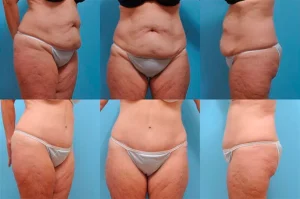Here we offer an overview of a breast implant capsulotomy with and without an implant exchange. However, before we do, let us show you the difference between breast reconstruction and augmentation, as many believe both are the same, but there is a difference.
Breast Reconstruction
Breast reconstruction is performed to restore the breast’s function and appearance, for example, after a mastectomy. It covers many options, from body tissue reconstruction, which is autologous tissue reconstruction and uses the body’s skin, fat or muscle to reconstruct the breast—second, using a breast implant vs. one’s body tissue to shape and fill the breast.
Third, regardless of the reconstruction technique, a tissue expander, a temporary saline implant that gradually stretches the muscle and skin to increase the breast mound size, is most often needed. And last, nipple and areola reconstruction falls into the breast reconstruction category.
Breast Augmentation
Breast augmentation, augmentation mammoplasty, or call by many a “boob job,” is one of the most common cosmetic procedures in the United States. The procedure is mainly done to enhance the size and shape of a woman’s breasts. Augmentation can be through fat transfer or implant placement under the chest muscle or breast tissue.
So what can happen after breast augmentation In NJ with implants?
Capsular Contracture
Complications can arise post-surgery with any surgical procedure. Capsular contracture after breast augmentation with implants is one.
When any new object is introduced into our body, a protective fibrous tissue, a capsule, forms.
Capsular contracture occurs after a breast implant when the capsule tightens, and dense scar tissue forms around it, causing it to harden and distort the breast’s appearance.
This condition can be uncomfortable and aesthetically displeasing for patients, leading them to seek treatment options such as breast implant capsulotomy, implant exchange, and placement of acellular dermal matrix.
Breast Implant Capsulotomy
Breast implant capsulotomy is a surgical technique to release the dense capsule which formed around the breast implant without totally removing it. The surgeon carefully cuts and releases the capsule, allowing the implant to regain its natural shape and mobility.
This capsulotomy technique can effectively treat capsular contracture by providing immediate relief to patients. The surgeon may also remove any excess scar tissue or replace the implant if necessary.
A capsulotomy is generally a safe and effective treatment; however, like with any treatment, there can be risks. Always speak with a medical professional before.
Implant Exchange
Implant exchange involves removing and replacing the existing breast implant with a new one. This procedure can be beneficial in treating capsular contracture as it eliminates the problematic implant that caused the condition in the first place. The surgeon may opt for a different type or size of implant to minimize the risk of recurring capsular contracture.
Additionally, implant exchange allows for a thorough evaluation of the breast pocket, enabling the surgeon to address any underlying issues that may have contributed to the development of capsular contracture.
Acellular Dermal Matrix (ADM) Placement
Acellular dermal matrix (ADM) placement has gained popularity in recent years to enhance further the success rate of treating capsular contracture. ADM is a biological material derived from human or animal tissue that serves as a scaffold for tissue regeneration.
When used in breast augmentation, ADM is positioned between the breast implant and the patient’s natural breast tissue. This additional layer helps to support the implant, prevent direct contact between the implant and the surrounding tissue, and reduce the risk of capsular contracture.
The placement of ADM in breast augmentation patients with capsular contracture offers several advantages:
- It provides additional support and coverage to the implant, reducing the risk of implant visibility or palpability.
- ADM acts as a barrier between the implant and the patient’s tissue, minimizing the inflammatory response and subsequent scar tissue formation that leads to capsular contracture.
- ADM promotes tissue integration, allowing for a more natural and stable result.
The combination of breast implant capsulotomy, implant exchange, and placement of acellular dermal matrix has proven to be an effective treatment approach for capsular contracture in breast augmentation patients.
These techniques address the condition’s symptoms and underlying causes, providing patients with improved comfort and aesthetic outcomes.
Speak With The Top-Rated Breast Reconstruction and Breast Augmentation Surgeons
As each person’s needs are different, each patient’s case is different; therefore, a highly qualified plastic surgeon should be the one to determine the appropriate treatment plan based on individual factors.
If you want to learn more about what can be done with your breasts or have recently had breast augmentation and find your implants are causing pain and discomfort, reach out to our medical professional plastic surgery center in Montclair, New Jersey. Our top-rated plastic surgeons will happily discuss what is best for you.
In the meantime, if you are interested in the best MedSpa in the Montclair, New Jersey, area, we would like you to try Arria MedSpa. We are confident you will be happy with their entire line of MedSpa services, from botox, fillers, laser treatments, cool sculpting, and so much more.




